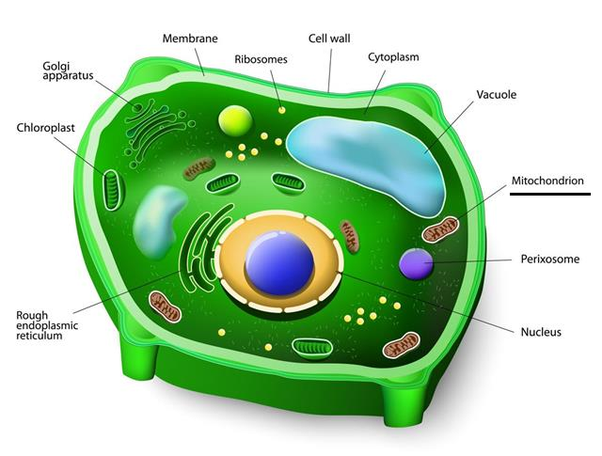
Do Plants Have Mitochondria?
Mitochondria are organelles found in the cells of most eukaryotic organisms, including plants. They are often referred to as the “powerhouses” of the cell because they are responsible for generating most of the cell’s supply of adenosine triphosphate (ATP), which is the primary energy currency of the cell. In plants, mitochondria play a crucial role in cellular respiration and energy production, working in conjunction with chloroplasts, which are responsible for photosynthesis.
Structure and Function of Plant Mitochondria
Plant mitochondria are surrounded by a double membrane, with an outer membrane that is relatively permeable to small molecules and an inner membrane that is highly impermeable. The inner membrane is folded inward, forming cristae, which increases the surface area for the enzymes involved in ATP production.Inside the inner membrane is the matrix, which contains the enzymes necessary for the citric acid cycle (also known as the Krebs cycle) and oxidative phosphorylation, the two main processes involved in ATP production.Plant mitochondria also contain their own DNA, which is circular and double-stranded. The mitochondrial DNA (mtDNA) is much larger than animal mtDNA, ranging from 200 to 2,000 kilobases in size, but it only contains about 50% more genes than animal mtDNA.
Unique Properties of Plant Mitochondria
Plant mitochondria have several unique properties that distinguish them from animal mitochondria:
- Ability to oxidize malate, glycine, and cytosolic NAD(P)H at high rates
- Partial insensitivity to rotenone, due to the presence of a second NADH dehydrogenase on the inner surface of the inner mitochondrial membrane
- Partial insensitivity to cyanide, due to the presence of an alternative oxidase on the inner surface of the inner mitochondrial membrane
- Larger mtDNA size (10-600 times larger than animal mtDNA) with a lower divergence rate for point mutations but higher recombinatorial activity
- Unique mitochondrial mRNA maturation process involving complex activities for processing, splicing, and editing (at hundreds of sites)
- Ability to produce novel reading frames through mtDNA recombination, which can lead to male sterility
- Large proteome with 2,000-3,000 different proteins, including many unique proteins such as 200-300 pentatricopeptide repeat proteins
Role of Mitochondria in Plant Metabolism
In plants, mitochondria are involved in various metabolic processes, including:
- Cellular respiration: Mitochondria are the primary site of ATP production through the processes of glycolysis, the citric acid cycle, and oxidative phosphorylation.
- Photorespiration: Mitochondria play a crucial role in the photorespiratory pathway, which helps plants cope with the inefficiency of the Rubisco enzyme in the Calvin cycle.
- Stress response: Mitochondria are involved in the plant’s response to various stresses, such as drought, heat, and pathogen attack.
- Programmed cell death: Mitochondria are thought to be involved in the initiation of programmed cell death (PCD) in plants.
Coordination with Chloroplasts
In photosynthetic plant cells, mitochondria and chloroplasts work together to optimize energy production and utilization. While chloroplasts are the primary site of energy production through photosynthesis, mitochondria play a crucial role in regulating the redox state and energy balance of the cell.Mitochondrial respiration provides flexibility to the metabolic pathways by adjusting enzyme capacities and regulating the supply and demand of metabolites. In actively photosynthesizing cells, mitochondria shift their role from being the primary energy producer to a thermodynamic buffering organelle.
Challenges and Future Prospects
Despite the significant progress made in understanding the structure and function of plant mitochondria, there are still many challenges and unanswered questions. One of the main challenges is to understand how the regulation of metabolism and mtDNA expression works at the cellular level and how retrograde signaling from mitochondria coordinates all the diverse processes in which they are involved.Future research in this area may focus on developing strategies to optimize plant productivity by slowing down unnecessary protein turnover, replacing or relocating metabolic activities, suppressing futile cycles, and making ion transport more efficient. This could involve engineering approaches to modify the structure and function of plant mitochondria to enhance their efficiency and flexibility in responding to changing environmental conditions and metabolic demands.
FAQ
- Do all plant cells have mitochondria?
Yes, mitochondria are found in almost all plant cells, with the exception of mature red blood cells and a few other specialized cell types. - Are mitochondria found only in plant cells?
No, mitochondria are found in the cells of most eukaryotic organisms, including plants, animals, and fungi. - What is the main function of mitochondria in plant cells?
The main function of mitochondria in plant cells is to generate ATP through the process of cellular respiration, which includes glycolysis, the citric acid cycle, and oxidative phosphorylation. - Do plant mitochondria have their own DNA?
Yes, plant mitochondria contain their own circular, double-stranded DNA (mtDNA), which is much larger than animal mtDNA but contains only about 50% more genes. - How do plant mitochondria differ from animal mitochondria?
Plant mitochondria have several unique properties compared to animal mitochondria, including the ability to oxidize malate, glycine, and cytosolic NAD(P)H at high rates, partial insensitivity to rotenone and cyanide, larger mtDNA size, unique mRNA maturation processes, and a larger proteome with many unique proteins.
References
- Møller, I. M., Rasmusson, A. G., & Van Aken, O. (2021). Plant mitochondria–past, present and future. The Plant Journal, 105(3), 473-490. doi:10.1111/tpj.15495
- Mitochondria in Plant Cells. (n.d.). Retrieved from https://study.com/academy/lesson/plant-cell-mitochondria-structure-role.html
| Characteristic | Plant Mitochondria | Animal Mitochondria |
|---|---|---|
| Size of mtDNA | 10-600 times larger than animal mtDNA | – |
| Genetic code | Standard genetic code, low divergence rate for point mutations | – |
| Recombination | High recombinatorial activity | – |
| mRNA maturation | Uniquely complex set of activities for processing, splicing, and editing (at hundreds of sites) | – |
| Proteome | Large proteome with 2,000-3,000 different proteins, including many unique proteins such as 200-300 pentatricopeptide repeat proteins | – |


